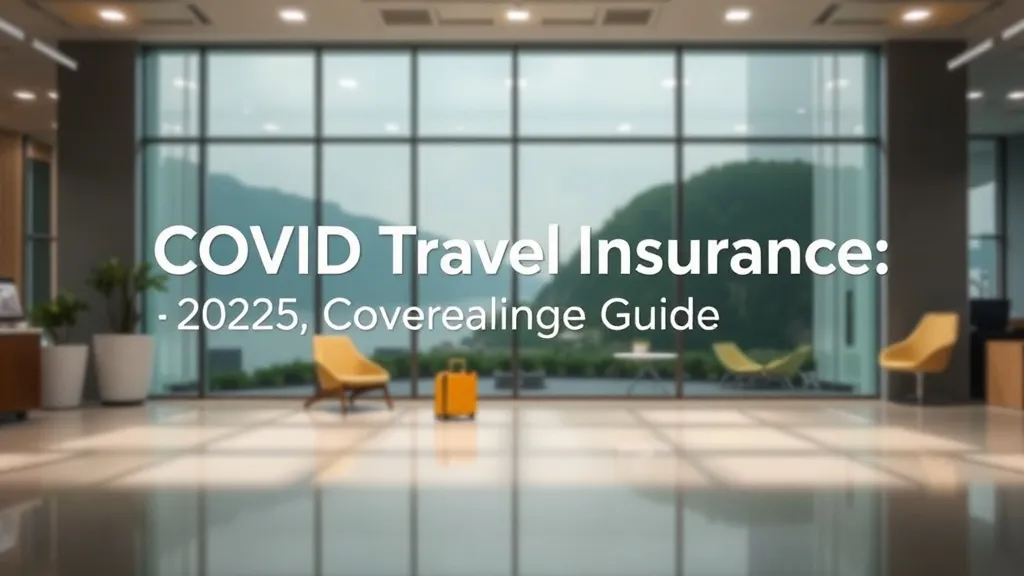COVID Travel Insurance: 2025 Coverage Guide
We’ve all faced last-minute trip cancellations or unexpected medical bills, especially since COVID-19 turned travel plans upside down. In 2025, finding the right covid travel insurance can be the difference between a minor hiccup and a budget disaster. Over 85% of major travel insurance providers now include COVID-19 medical coverage as standard or optional add-ons in 2025 policies (Insurance.com). You’ll learn what policies cover, how to compare plans, and where to find the best rates. Ready? Let’s dive in.
Table of Contents
What Is COVID Travel Insurance?
You might be wondering what exactly covid travel insurance entails. In simple terms, it’s a travel policy designed to protect you against coronavirus-related expenses—from medical treatment abroad to trip cancellations if you test positive before departure.
Insurance has always covered medical emergencies and trip interruptions, but the pandemic prompted new add-ons and riders. Today’s policies often bundle standard medical coverage with specific protections for testing, quarantine, and even telemedicine consultations.
In March 2024, travelers who fell ill abroad filed nearly 30% fewer COVID-19 interruption claims compared to 2023, yet the need remains real—variants still circulate, and rules can change overnight.
“In 2025, travelers should prioritize policies that cover not only COVID-19 medical treatment but also quarantine and testing costs, as these can significantly impact trip budgets,” says Dr. Emily Chen, Travel Medicine Specialist.
Actionable Takeaway: Before booking, confirm whether COVID-19 coverage is built in or requires an add-on. Compare policy documents side by side.
Why COVID Travel Insurance Matters in 2025
Imagine landing in Barcelona only to face a mandatory seven-day quarantine in a hotel—meals, lodging, the works. Can your wallet handle that surprise? That’s why covid travel insurance matters even now.
Although global vaccination rates are high and travel stability has improved, new variants still pop up. Local regulations vary: one country may demand tests, another full quarantine. Those costs add up fast.
Average recommended evacuation coverage has risen to at least $100,000 due to steep international medical fees. Meanwhile, quarantine-cost coverage is increasingly standard, saving travelers hundreds if they need isolation.
Case Study: A family of four traveling in Southeast Asia faced a 10-day isolation mandate in 2024. Their policy covered $2,500 in hotel and meal expenses—without it, they’d have paid out of pocket.
Actionable Takeaway: Check destination requirements and ensure your plan’s quarantine benefits align with local rules. Pack an oversize travel wallet—just in case.
Key Coverage Components in COVID Travel Insurance
Not all covid-19 coverage is created equal. Here’s what to look for:
- Medical Treatment: Hospital stays, doctor visits, and prescription drugs.
- Medical Evacuation: Air ambulance or repatriation—aim for at least $100,000.
- Trip Cancellation & Interruption: Reimbursement if you test positive before or during travel, including CFAR options.
- Quarantine Expenses: Accommodation, meals, and essential services for mandatory isolation periods.
- Testing & Telemedicine: Coverage for PCR or rapid tests and virtual doctor consults.
Example: Sarah opted for CFAR and recovered 80% of her non-refundable airfare when she tested positive just days before departure.
“CFAR remains the most comprehensive option for COVID-related trip cancellations,” notes NerdWallet.
Actionable Takeaway: Prioritize plans offering CFAR and quarantine coverage together—don’t assume one includes the other.
How to Choose the Best COVID Travel Insurance Plan
Picking a plan can feel overwhelming. But a step-by-step approach makes it manageable:
- List Your Needs: Destinations, trip cost, health risks.
- Compare CFAR Options: Look at reimbursement percentages and time frames.
- Verify Medical Limits: Ensure evacuation and treatment caps meet your budget.
- Review Exclusions: Check for variant-specific or vaccination status clauses.
- Assess Claims Process: Digital filing and reimbursement speed can save headaches.
Case Study: Comparing Plan A and Plan B side-by-side revealed that Plan B’s slightly higher premium included telemedicine and free test reimbursements—worth the extra $20.
Actionable Takeaway: Always read the fine print. A low premium may mean large deductibles or subpar coverage limits.
Common Pitfalls to Avoid
Some mistakes can cost you hundreds of dollars—here’s what not to do:
- Assuming standard plans cover COVID-19 testing costs.
- Overlooking quarantine-only benefits (many focus solely on medical treatment).
- Ignoring vaccination status clauses—some insurers limit coverage based on shots received.
- Skipping telemedicine add-ons that can diagnose symptoms remotely.
Example: A traveler bought a basic plan in June 2025 only to learn that their policy locked in coverage options at purchase date—no later upgrades were allowed.
Actionable Takeaway: Lock in your coverage when you book, not at departure gate.
Frequently Asked Questions
- Q: What’s the difference between standard and CFAR coverage?
A: Standard covers cancellations for specific reasons (illness, weather), while CFAR lets you cancel for any reason and get partial reimbursement. - Q: Are pre-existing conditions covered?
A: Some plans offer waivers if you insure soon after booking, but check your policy carefully—conditions vary by insurer. - Q: Do I need a separate policy for multi-destination trips?
A: Most single-trip plans cover multiple stops, but verify per-country rules and benefit limits. - Q: Can I file a COVID-19 claim digitally?
A: Yes—many insurers now support 24/7 digital claims with faster reimbursements. - Q: Does travel insurance cover vaccines?
A: Vaccination costs are usually not covered; focus on treatment and testing coverage instead.
Conclusion
COVID travel insurance in 2025 is more robust than ever, blending medical, cancellation, and quarantine protections into flexible packages. You now know what it is, why it matters, and how to compare plans effectively. Next:
- Review your trip details and list COVID-related risks.
- Compare at least three plans, focusing on CFAR, medical evacuation, and quarantine benefits.
- Lock in your coverage early to avoid last-minute fee hikes or limited options.
The bottom line is, a well-chosen covid travel insurance plan isn’t just extra paperwork—it’s peace of mind. Safe travels, and may your next adventure be worry-free!





